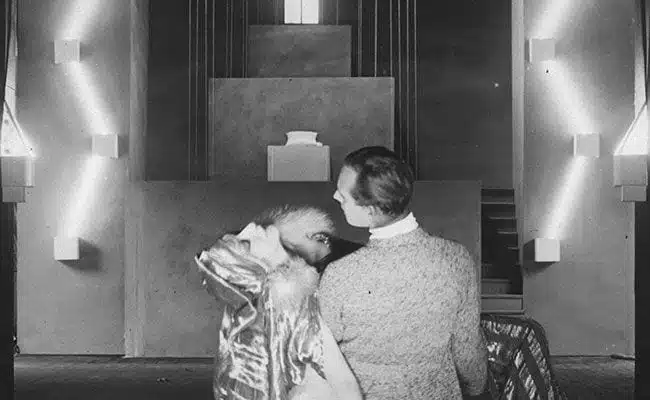
A cornerstone in silent cinema’s art deco period, L’inhumaine has held title as a curious amalgam made up of many narrative threads. A strange fusion of drama, fantasy, sci-fi and romance, Marcel L’Herbier’s exercise in mythic epic appears more like a manifesto on the nature of inspiration than a film that makes any momentous statement on the human condition à la Metropolis.
A diamond-cut soap opera about a coldly ambitious woman’s exploits in show business, L’inhumaine tells the story of Claire, a highly revered singer who commands the attention of thousands of adoring fans. Some of the more affluent members of her fan base include inventors, Indian royalty, artists and great thinkers.
Among them is Einar, an inventor who is hopelessly in love with Claire but rather naïve in the ways of love and romance. While all the other more personable men stumble over one another to get Claire’s attention, Einar silently pines for her from a distance.
When the dashing Djorah de Nopur, a regal Indian bachelor, sets his eye on the enigmatic singer, the young inventor is driven into jealous fits, which literally send him round the bend (on a mountain road) and over a cliff. Claire decides to take this one off the chin; she’s too preoccupied with the complications of fame. But guilt brings her back to Einar.
When it’s discovered that Einar has not died from the accident after all, Claire is introduced into a strange mechanical world of invention — one that the impossibly lovesick Einar has built especially for the singer. And one that will eventually save her from tragic consequences precipitated by the now jilted Djorah.
Smart, sharp and fashionably ahead of its time, L’inhumaine’s narrative hangs in an aesthetic balance between the cerebral pretensions of a popular literary novel and the continental-chic of a glamour magazine. Throughout the film, there are structural cues from the story’s environment that visually inform the narrative and its thematic schemes; strewn about are elegant art deco shapes which refer to the cunning charms of a wasted troupe of social-climbers.
Even in the panicked, artsy movements of an intermittently roving and static camera, there are the stylish underpinnings of a futurist design that process the story with edgy inventiveness. There are the herky-jerky movements of characters who manoeuvre through the narrative with freakish angularity plus the softer contours of matinée-styled framing, which round out the vampishly camp demonstrations.
Much of L’inhumaine’s style is rested within the characters themselves, and L’Herbier employs a kind of costuming designed entirely for effect. Mask-wearing servants denote the airs of a floating, pervasive evil, as do the East-Asian accents lamentably demonized in Indian character Djorah de Nopur. Claire (played by the mysteriously unprolific Georgette Leblanc), the central figure in this byzantine drama, vibrates with a sense of impending doom when buried in the ruffles of feathers and silk. Everything onscreen has been carefully arranged to invoke the machinery radiance of a prosperous world and the actors themselves become variables in a winding and shifting narrative where their characters are transformed by the imaginative getups.

For all of its flashy and mechanical brilliance, there’s still the spool of emotional thread that unwinds as the narrative progresses. There’s a clipped, abstracted poetry to the telling of this story that defies the geometric constructs of the plot these characters are confined in. It’s a poetry spun from, and around, every sequential corner of this marbled tale; existential musings on the nature of art are dispensed in the brooding monologues while guilt complexes and Freudian desires are expressed in feather-boa dramaturgy. Beneath its art deco style-guide, L’inhumaine proves to be a story of inspiration and daring.
Flicker Alley presents a stunning transfer with clear picture and sound. Images are flush with colours that are rich and vibrant. The colour-coded sequences (sepia, magenta, lime-green, silver-blue) are delightfully prepared eye-candy made all the more appealing by the impeccable work that has been done on the print cleanup.
Especially impressive are the two musical audio tracks that have been supplied here on this blu-ray release. The first track by Aidje Tafial is a playful clockwork-contraption of electronic and jazz-cadenced sounds. It offers the film an atmosphere of curious discovery, perfectly suited to appeal to the more sci-fi and fantasy elements of the story. The second track by the Alloy Orchestra presents a more traditional orchestral arrangement with strings that plays on the more sentimental qualities of the tale. Both scores are fantastic, each track offering the story a mood and tonal atmosphere entirely separate from one another.
There’s a thoughtful set of extras on the disc, which include a small behind-the-scenes feature and another feature on the recording of Tafial’s score. A handsome essay booklet is also included; inside there are write-ups on the film and plenty of photos. As this is a silent film, there are subtitles provided, which are available here in both English and French.
Often in L’inhumaine, it’s easy to let the images simply wash over you; so easy on the eyes are the images that the narrative tapestry sometimes threatens to become merely an afterthought. Yet what we are presented with here is a story of emotion that pulses slowly and steadily with the suspense of a slow-burning thriller. Amidst the fanciful sequences of jazz-age shenanigans and tear-jerking exploits, there’s a literary tale of relationships and romance in L’inhumaine worthy of discovery.

